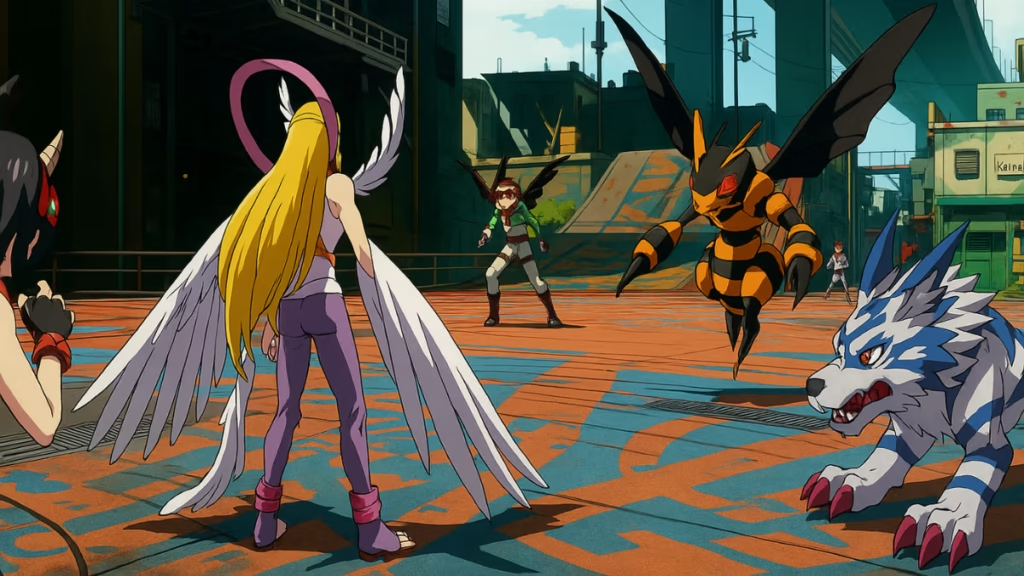It’s been nearly a decade since Digimon Story: Cyber Sleuth gave fans a proper story-driven RPG outside Japan. Cyber Sleuth and its companion title Hacker’s Memory built a loyal following, and ever since then, fans have been waiting for Bandai Namco to deliver a true successor. Now, after years of anticipation, Digimon Story: Time Stranger finally arrives—and while it isn’t flawless, it proves to be a worthy addition to the series.
The big question: was it worth the wait? The answer is mostly yes. Time Stranger offers one of the most ambitious Digimon stories to date, with excellent combat depth and a wide cast of creatures to raise, but it’s also held back by uneven pacing, thin side content, and an overreliance on DLC.

Time Stranger introduces players to Iliad, a new digital world separate from past Digimon Story titles. You play as an agent of ADAMAS, investigating strange occurrences that bridge the human and digital realms. Early events lean heavily on exposition, with your unchosen protagonist variant constantly dumping lore through your Digivice. It’s clumsy at first, but once the narrative settles, it begins to shine.
The central conflict pits players against a high-stakes struggle involving the Olympos XII—Digimon modeled after Greco-Roman deities—and the Titans, with Tokyo itself caught in the chaos. While some beats stumble, the story builds momentum and ends up delivering several strong twists, ensuring fans walk away with memorable characters and a renewed appreciation for Digimon lore.
Core Gameplay and Battle Mechanics
At its heart, Time Stranger is a turn-based JRPG with a monster-raising core loop that keeps players hooked.
- Tracing and Digivolution: Instead of catching Digimon, you scan enemies to collect data. At 100% you can convert them into party members, but waiting until 200% yields stronger variants. From there, branching Digivolution paths allow near-limitless experimentation, reinforced by the Bond system that carries over stats across evolutions and de-evolutions.
- Type and Element System: Each Digimon belongs to a classic Virus, Vaccine, or Data type, alongside an elemental affinity. Using the right attack can swing damage multipliers dramatically, adding depth to boss battles.
- Battle Quality of Life: Auto-battle, adjustable speed multipliers, and the ability to use items without consuming a turn streamline grinding and exploration. This makes Time Stranger easy to play casually while still offering tactical challenge in tougher encounters.
- Skill Trees and Agent Rank: Completing missions boosts your Agent Rank, unlocking new abilities and perks. This ensures steady progression beyond just raising Digimon stats.
The result is a system that blends old-school JRPG design with modern conveniences, making combat fast, tactical, and rewarding.
Side Content and DLC Concerns
Unfortunately, Time Stranger stumbles when it comes to side activities. Mini-games like Jogmon: The Ultimate Card Game sound exciting on paper but feel underdeveloped and tedious in practice. Side quests exist, but many are dull fetch tasks delivered with too much handholding. A few standout moments appear later in the campaign, yet they’re too sparse to elevate the whole package.
The bigger frustration comes from DLC practices. While the standard edition costs $69.99, Deluxe and Ultimate Editions climb as high as $119.99. Some side quests are locked behind day-one DLC, and the In-Between Theatre introduces microtransaction-based mini-dungeons that feel like free-to-play intrusions in a premium-priced game. It’s a blemish on an otherwise strong package.
Performance Across Platforms
Visually, Time Stranger embraces a bold anime-inspired aesthetic. Character models are expressive, Digimon designs are full of personality, and combat animations bring the creatures to life. The soundtrack is mostly strong, though a few tracks can grate during long play sessions.
Performance is solid across platforms. On PC, even mid-tier hardware runs the game at stable framerates, while handheld play on Steam Deck feels smooth with minor tweaks. The game’s vibrant style helps it stand out even if it isn’t pushing cutting-edge visuals.
Pros and Cons
Pros
- Engaging story with memorable twists and characters
- Deep Digivolution and personality systems that reward experimentation
- Strategic battle mechanics with strong quality-of-life features
- Wide roster of over 400 Digimon to recruit and raise
- Expressive art direction and strong soundtrack
Cons
- Weak and repetitive side content
- Day-one DLC and microtransaction intrusions in a full-priced game
- Uneven pacing in early hours and occasional clunky exposition
Final Verdict
Digimon Story: Time Stranger is a game defined by contrasts. On one side, it offers one of the best Digimon RPG experiences to date, complete with a heartfelt story, satisfying progression, and smartly designed combat. On the other, it undercuts itself with uninspired side quests and questionable monetization.
For fans, this is still a must-play—a vibrant, ambitious entry that expands Digimon’s universe while providing dozens of hours of monster-raising fun. For newcomers, it’s approachable enough to serve as a gateway, even if the early hours feel heavy on lore. Play Now!
Digimon Story: Time Stranger – Review Score
Overall Rating: ★★★★☆ (8/10)
| Category | Score |
|---|---|
| Story & Characters | 8.5/10 |
| Gameplay & Systems | 9/10 |
| Presentation | 8/10 |
| Content & Replay Value | 7/10 |
| Value for Money | 8.5/10 |
See also: Hotel Barcelona Review – Roguelite Horror With Style and Flaws

